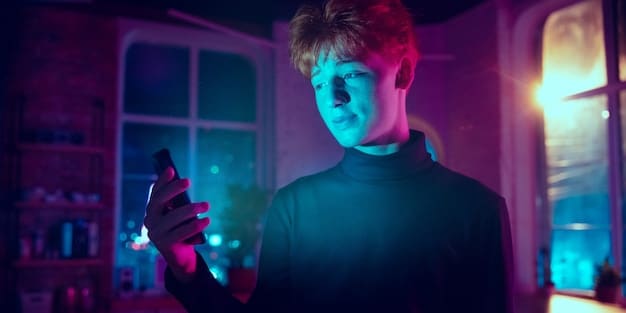Snapchat’s New AR Lenses: Engaging Users in the US

Snapchat’s new AR lenses are revolutionizing user engagement in the US by offering immersive and interactive augmented reality experiences, expanding creative expression and fostering deeper social connections within the platform’s ecosystem.
In the dynamic landscape of social media, innovation is key to capturing and retaining user attention. Snapchat’s New AR Lenses: Engaging Users with Augmented Reality in the US represents a significant leap forward, transforming how individuals interact with digital content and each other. These advanced lenses are not just filters; they are immersive experiences that blend the digital with the physical, creating a new dimension of creativity and connection.
The Evolving Landscape of Augmented Reality on Snapchat
Augmented Reality (AR) has long been a foundational element of Snapchat’s appeal, distinguishing it from other social media platforms. What began with simple face filters has evolved into a sophisticated ecosystem of interactive Lenses that significantly enhance user engagement. This evolution reflects a broader trend towards more immersive and personalized digital experiences, particularly within the United States.
Snapchat’s continuous investment in AR technology underscores its commitment to innovation. Unlike virtual reality (VR), which creates entirely simulated environments, AR overlays digital content onto the real world, making it more accessible and integrated into daily life. This seamless integration is crucial for fostering a sense of natural interaction and fun among users.
From Novelty to Utility: The Rise of Advanced AR
Initially, Snapchat’s AR features were primarily seen as a playful novelty. Users delighted in transforming their faces into absurd characters or adding whimsical elements to their surroundings. However, the platform has steadily pushed the boundaries, turning these playful interactions into tools with diverse utility.
- Enhanced Storytelling: AR Lenses allow users to tell stories in more dynamic and visually rich ways, adding layers of context and emotion that static images or videos cannot achieve.
- Interactive Games: Many Lenses now incorporate game-like elements, turning casual interactions into engaging challenges that encourage repeat use and longer session times.
- Virtual Try-On: Brands leverage AR for virtual try-on experiences, enabling users to digitally test products like makeup, clothing, or furniture before making a purchase, blurring the lines between online and offline shopping.
Understanding the unique ways in which AR has matured on Snapchat helps contextualize the impact of its newest lenses. These aren’t just incremental updates; they represent a strategic push to deepen engagement by offering experiences that are increasingly relevant, creative, and integrated into user habits.
Diving Deep into Snapchat’s Latest AR Lens Innovations
Snapchat’s recent rollout of new AR lenses signifies a leap in immersive technology, pushing the boundaries of what augmented reality can offer to its vast user base in the US. These innovations are not merely aesthetic enhancements; they represent advancements in tracking, realism, and interactive potential, designed to captivate and retain users through novel experiences.
One of the most notable aspects of these new lenses is their heightened sophistication in recognizing and reacting to the user’s environment. Older lenses might simply overlay an effect; the latest iterations can understand depth, surface, and even the nuances of human movement, allowing for more dynamic and responsive AR activations.
Hyper-Realistic Interactions and Environmental Integration
The focus on hyper-realism means that digital objects now blend more seamlessly into the real world. For example, a virtual pet might cast a shadow that reacts to changes in light, or a digital artwork could appear to be physically attached to a wall, complete with realistic textures and reflections. This level of detail elevates the AR experience from a flat filter to a truly interactive digital layer.
- Advanced Tracking: Improved tracking capabilities allow lenses to follow movements more precisely, whether it’s a user walking through a park or a car driving down a street, ensuring digital elements remain anchored to their intended positions.
- Enhanced Lighting Effects: The new lenses incorporate sophisticated lighting algorithms that can adapt to the ambient light of the user’s environment, making AR objects appear naturally lit and integrated.
- Complex Animations: Beyond simple static overlays, the latest lenses feature intricate animations, bringing virtual characters and objects to life with fluid motion and expressive details.
These technological advancements open up new avenues for creative expression and brand engagement. Users are no longer passive recipients of AR effects; they become active participants, choreographing their surroundings with digital elements in ways previously unimaginable.
Another area of innovation involves the integration of external data and real-time feeds. While details are often proprietary, the intent is clear: to make AR lenses even more contextually aware and responsive, perhaps reacting to weather patterns, time of day, or geo-located events.
These advancements are clearly aimed at maintaining Snapchat’s competitive edge in the highly saturated social media market. By offering cutting-edge AR experiences, the platform hopes to solidify its position as the go-to app for innovative and personalized digital interactions, particularly appealing to a younger, tech-savvy demographic in the US.

Impact on User Engagement and Retention in the US
The introduction of Snapchat’s new AR lenses has a profound impact on user engagement and retention, particularly within the US market. These advanced features are not just about novelty; they tap into fundamental psychological aspects of user interaction, fostering creativity, personal expression, and social connection in unique ways.
At its core, higher engagement translates to more time spent on the app, more content creation, and increased interaction with other users. Snapchat understands that static content can quickly become monotonous in the fast-paced digital world. AR, by its very nature, demands interaction and active participation, turning passive consumption into active creation.
Fostering Creativity and Self-Expression
The new lenses provide users with infinitely more tools for self-expression. Beyond simple filters, these are interactive canvases where users can manipulate their environment, transform their appearance in fantastical ways, or even create miniature digital worlds within their physical space. This creative outlet is a powerful driver of engagement.
- Personalized Content Creation: Users can customize these lenses or use them as a foundation for their unique content, making their Snaps more distinct and reflective of their personality.
- Collaborative Experiences: Many new lenses support multi-user interactions, allowing friends to collectively experience and create AR content, strengthening social bonds within the app.
- Sense of Ownership: The ability to manipulate and personalize AR content gives users a stronger sense of ownership over their digital creations, encouraging them to share and showcase their work.
This creative freedom leads to a virtuous cycle: the more users engage with these tools, the more unique content is generated, which in turn attracts more viewers and encourages further creation. Unlike traditional photo filters, AR content often prompts comments, shares, and direct messages, deepening the social aspect of the platform.
Furthermore, the element of surprise and discovery inherent in AR experiences keeps users coming back. Snapchat regularly updates its lens catalog, ensuring there’s always something new to explore. This constant novelty combats user fatigue and provides a compelling reason for daily engagement.
For brands and advertisers, this increased engagement is invaluable. AR lenses offer highly interactive advertising opportunities, allowing companies to present their products in engaging, experiential ways that resonate more deeply with users than traditional ads. This integration of advertising into enjoyable user experiences is a subtle yet powerful retention mechanism.
Challenges and Opportunities for AR in Social Media
While augmented reality presents immense opportunities for user engagement in social media, it also comes with its own set of challenges. Navigating these requires a blend of technical innovation, strategic planning, and a deep understanding of user behavior. For platforms like Snapchat, which heavily invest in AR, addressing these hurdles is crucial for sustained growth in the US market and beyond.
One primary challenge lies in the technical demands of AR. Creating seamless, high-quality AR experiences requires significant computational power, advanced camera technology, and sophisticated algorithms. Ensuring these run smoothly across a diverse range of devices, from high-end smartphones to older models, is a constant balancing act.
Technical Complexities and User Accessibility
Optimizing AR lenses for performance without compromising visual fidelity is an ongoing battle. Issues like lagging, inaccurate tracking, or glitches can quickly break the immersive illusion and lead to user frustration. Moreover, the average user doesn’t care about the underlying tech; they simply expect a flawless experience. This creates a high bar for development and deployment.
- Device Fragmentation: The vast array of smartphone models and operating systems means AR experiences must be optimized for diverse hardware specifications, which can lead to inconsistencies.
- Battery Consumption: Running complex AR applications is energy-intensive, often leading to rapid battery drain, which can deter users from prolonged engagement.
- Data Usage: Downloading and processing AR content can consume significant data, especially for users with limited data plans, potentially impacting accessibility.
Beyond the technical, there are significant opportunities for AR to evolve. One major area is the monetization of AR experiences. Brands are already leveraging AR for virtual try-ons and interactive advertisements, but the potential for deeper integration of commerce and entertainment within AR is still largely untapped.
Another exciting opportunity lies in the development of persistent AR. Unlike current lenses that reset with each use, persistent AR would allow digital objects to remain anchored in real-world locations for extended periods, opening doors for collaborative storytelling, public art installations, and even educational applications.
Finally, fostering a thriving creator ecosystem around AR is paramount. Empowering independent developers and artists to build and share their own lenses is crucial for diversifying content and keeping the platform dynamic. Snapchat’s Lens Studio is a step in this direction, but continued support and innovation in this area will be key to unlocking AR’s full potential in social media.
The Future of AR and Social Interaction on Snapchat
The trajectory of augmented reality on Snapchat indicates a future where digital interactions become increasingly integrated with our physical world, blurring the lines between the two. This evolution is set to redefine social communication, shifting away from purely text-based or static image exchanges towards dynamic, shared AR experiences. In the US, this trend is particularly pronounced, with users actively seeking novel ways to express themselves and connect.
Snapchat’s strategic focus on AR suggests a move towards a more spatial internet, where shared virtual content can augment real-world locations and social gatherings. Imagine attending a concert where AR elements enhance the live performance for everyone simultaneously, or a family gathering where personalized digital decorations appear around your home only through your phone’s camera.
Beyond Filters: Shared Augmented Worlds
The vision extends far beyond simple face filters. Future iterations of Snapchat’s AR technology could facilitate persistent, collaborative AR environments. This means digital objects and experiences could exist in shared public or private spaces, viewable and interactable by multiple users over time, not just during a single session.
- Enhanced Group Experiences: AR could allow multiple users in the same physical space to interact with the same virtual objects, from playing games with shared digital characters to collaborating on an AR art piece.
- Location-Based AR: Imagine unlocking unique AR experiences tied to specific landmarks or venues, offering interactive tours or hidden digital content only accessible on-site.
- Digital Twins: The potential for creating “digital twins” of real-world objects or even entire environments, where users can interact with virtual representations of physical spaces, opens up new avenues for remote collaboration and visualization.
This shift towards shared augmented reality experiences has profound implications for social interaction. It provides a new medium for communication that leverages spatial understanding and real-time responsiveness, adding depth and context that flat media often lack.
Furthermore, the integration of AR with Artificial Intelligence (AI) will likely lead to even more intelligent and reactive lenses. AI could enable lenses to understand complex social cues, adapt to emotional expressions, or even generate personalized AR content on the fly, making interactions more intuitive and engaging.
Ultimately, the future of AR on Snapchat is about making digital and physical worlds converge in a way that feels natural, intuitive, and enhances human connection. It’s about moving from passive consumption to active, immersive participation, promising a more playful, creative, and interconnected social experience for users in the US.
Competitive Edge: How Snapchat’s AR Stands Out
In the fiercely competitive realm of social media, maintaining a distinct competitive edge is paramount. For Snapchat, augmented reality has been precisely that differentiator, allowing it to carve out a unique niche distinct from giants like Meta (Facebook/Instagram), TikTok, and X. While other platforms have dabbled in AR filters, Snapchat’s deep, longstanding commitment to the technology positions it as a leader, particularly in the US market.
The fundamental difference lies not just in the presence of AR, but in its integration within the core user experience and the level of sophistication offered. Snapchat didn’t just add AR as an afterthought; it built its very identity around ephemeral, visually rich communication powered by innovative lenses.
Deep Integration vs. Superficial Filters
Unlike competitors where AR often feels like an add-on, Snapchat’s AR is woven into the fabric of its platform. This deep integration allows for more fluid transitions between reality and augmentation, making the experience feel natural and intuitive for users. The quality of its AR tracking, environmental understanding, and diverse lens library typically surpasses what’s available elsewhere.
- Proprietary Technology: Snapchat invests heavily in its own AR research and development, including advanced computer vision and machine learning, giving it a lead in creating cutting-edge lenses not easily replicated.
- Creator Ecosystem: The robust Lens Studio platform empowers a vast community of creators to develop innovative and often viral AR experiences, constantly refreshing the content and keeping offerings unique.
- Targeted Demographics: Snapchat’s primary user base, particularly in the US, skews younger and is often more receptive to innovative, engaging visual features, which AR perfectly caters to.
Furthermore, Snapchat’s approach to AR extends beyond mere entertainment. Through initiatives like “Connected Lenses” and “Scan,” it’s integrating AR with utility, commerce, and information discovery. This strategic diversification solidifies its position as a platform where AR is both fun and functional.
While competitors might mimic certain AR features, they often lack the breadth, depth, and seamless integration that Snapchat offers. This sustained focus has allowed Snapchat to foster a loyal user base that perceives it as the go-to platform for groundbreaking AR experiences, ensuring its relevance and continued growth in the dynamic social media landscape.
User Perspectives and Feedback: Driving AR Evolution
Understanding user perspectives is crucial for any platform’s success, and Snapchat is no exception, especially when it comes to the highly interactive domain of augmented reality. User feedback, both implicit through usage patterns and explicit through surveys and social media commentary, plays a pivotal role in shaping the evolution of Snapchat’s AR lenses in the US.
The beauty of a platform like Snapchat is its direct line to its users. The ephemeral nature of Snaps means trends emerge and change rapidly, providing real-time data on what resonates. This agility in response to user preferences allows Snapchat to quickly iterate and introduce new AR features that genuinely appeal to its audience.
What Users Love and What They Want Next
Users consistently express enthusiasm for lenses that are:
- Highly creative and whimsical: Lenses that offer a sense of magical transformation or allow for playful distortions are always popular.
- Socially engaging: Multi-user lenses or those that spark conversations and collaborations tend to have greater viral potential.
- Contextually relevant: Lenses tied to current events, holidays, or popular culture themes often see a surge in usage, as they allow users to participate in broader cultural moments.
Beyond positive reception, critical feedback also informs development. Users often request improved performance on older devices, less battery drain, and greater customization options for existing lenses. They also express interest in more practical AR applications, like advanced navigation aids or educational tools integrated into the camera view.
Snapchat’s strategy involves not just listening to direct feedback but also observing how lenses are used creatively in unexpected ways. This bottom-up innovation, where users adapt and repurpose existing features, often inspires future developments, leading to a truly user-driven evolution of the AR experience.
The relationship between Snapchat and its user base is symbiotic. Users provide the engagement and creative input, and Snapchat responds with increasingly sophisticated and enjoyable AR tools. This continuous feedback loop ensures that the platform remains at the forefront of AR innovation, delivering experiences that truly resonate with its US audience.
| Key Aspect | Brief Description |
|---|---|
| ✨ AR Innovation | Snapchat’s new lenses enhance realism, tracking, and interactivity, moving beyond basic filters to immersive experiences. |
| 📊 User Engagement | These lenses boost creativity, self-expression, and social connection, leading to increased app usage and content creation. |
| 🚀 Future Outlook | Expect more shared, persistent, and AI-powered AR experiences, deeply integrating digital with physical social interactions. |
| 📈 Competitive Edge | Snapchat’s long-standing AR focus and robust Lens Studio set it apart from competitors, maintaining its unique platform identity. |
Frequently Asked Questions about Snapchat AR Lenses
▼
The latest Snapchat AR lenses feature significant advancements in hyper-realism, including improved tracking capabilities for precise movement, sophisticated lighting algorithms for natural integration with environments, and complex animations that bring virtual elements to life with remarkable fluidity. These innovations allow digital objects to interact more realistically with the user’s surroundings, enhancing immersion.
▼
New AR lenses boost user engagement by fostering greater creativity and self-expression. They provide personalized content creation tools, encourage collaborative experiences among friends, and instill a stronger sense of ownership over user-generated content. This leads to more time spent on the app, increased content sharing, and deeper social interactions, driving overall platform activity and retention in the US.
▼
Snapchat faces several challenges, including the technical demands of running high-quality AR across diverse devices, managing significant battery consumption, and optimizing data usage. Ensuring seamless performance on a wide range of smartphones while maintaining visual fidelity is a constant balancing act. These technical complexities require continuous innovation and optimization efforts.
▼
Snapchat distinguishes itself through its deep, proprietary integration of AR within its core user experience, rather than treating it merely as an add-on. Its long-standing investment in AR research and development, combined with a robust Lens Studio for creators, results in a more sophisticated and diverse range of AR experiences. This allows it to maintain a unique competitive edge and leadership in the AR space.
▼
The future of AR on Snapchat points towards more shared, persistent augmented worlds, where multiple users can collectively interact with digital objects anchored in real-world spaces. This could involve enhanced group experiences, location-based AR content, and potentially “digital twins” of physical environments. The integration of AI will also likely lead to more intelligent and adaptive AR interactions, enriching social connections.
Conclusion
The continuous innovation in Snapchat’s New AR Lenses: Engaging Users with Augmented Reality in the US is more than just a technological showcase; it represents a strategic evolution in how social media platforms can foster deeper connection and creativity. By pushing the boundaries of realism, interactivity, and collaborative potential, Snapchat is not merely adapting to user demands but actively shaping the future of digital interaction. As AR becomes an increasingly integral part of our daily lives, Snapchat’s commitment to this technology ensures its continued relevance and its position at the forefront of the immersive social media experience, offering a glimpse into a future where our physical and digital worlds are seamlessly intertwined.





